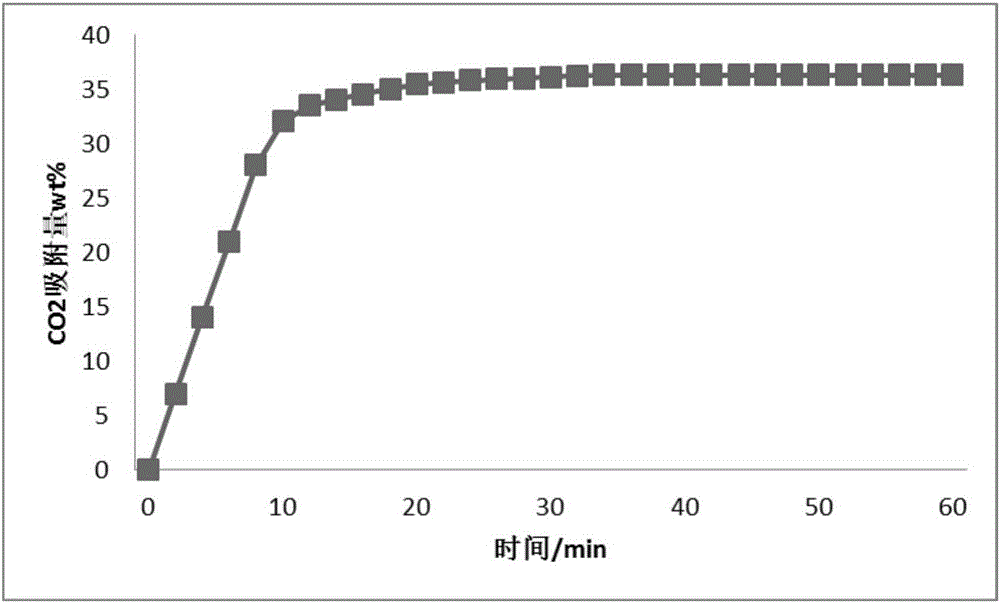Method for preparing Na-doped carbon dioxide adsorbent ceramic by template method
A carbon dioxide and adsorbent technology, which is applied in the field of preparing Na-doped carbon dioxide adsorbent ceramics by a template method, can solve the problems that the adsorption effect needs to be improved, stay, etc., and achieves a high carbon dioxide adsorption capacity, promotes the gel process, and has a high specific surface area. Effect
- Summary
- Abstract
- Description
- Claims
- Application Information
AI Technical Summary
Problems solved by technology
Method used
Image
Examples
Embodiment 1
[0030] A method for preparing Na-doped carbon dioxide adsorbent ceramics by a template method, comprising the following preparation steps:
[0031] (1) Prepare materials, zirconium source is zirconium oxynitrate, lithium source is lithium nitrate; Catalyst is acidic catalyst; Lye is ammonia water; Binding agent is glycerol; Coagulant is propylene oxide; Templating agent is PEG20000;
[0032] (2) Dissolve the zirconium source, lithium source, catalyst, binder, and templating agent in deionized water according to a certain ratio, then slowly add lye, and stir at 80°C for 3 hours to form a transparent sol;
[0033] (3) Then raise the temperature to 85°C, add a coagulation accelerator to obtain a gel precursor;
[0034] (4) Grind and disperse the lithium zirconate precursor in a mortar, add activated carbon, then add water glass, wherein the addition of water glass accounts for 7wt% of the mixture, grind again, and then carry out hot pressing molding. First sintering at 400°C for...
Embodiment 2
[0040] A method for preparing Na-doped carbon dioxide adsorbent ceramics by a template method, comprising the following preparation steps:
[0041] (1) Prepare materials, zirconium source is zirconium oxynitrate, lithium source is lithium nitrate; Catalyst is acidic catalyst; Lye is ammonia water; Binding agent is glycerol; Coagulant is propylene oxide; Templating agent is PEG20000;
[0042] (2) Dissolve the zirconium source, lithium source, catalyst, binder, and templating agent in deionized water according to a certain ratio, then slowly add lye, and stir at 80°C for 3 hours to form a transparent sol;
[0043] (3) Then raise the temperature to 85°C, add a coagulation accelerator to obtain a gel precursor;
[0044] (4) Grind and disperse the lithium zirconate precursor in a mortar, add activated carbon, grind again, and then perform hot pressing molding. After molding, sinter at 400 degrees Celsius for 2 hours, and then proceed at 600 degrees Celsius. Secondary sintering wit...
Embodiment 3
[0050] A method for preparing Na-doped carbon dioxide adsorbent ceramics by a template method, comprising the following preparation steps:
[0051] (1) Prepare materials, zirconium source is zirconium oxynitrate, lithium source is lithium nitrate; Catalyst is acidic catalyst; Lye is ammonia water; Binding agent is glycerol; Coagulant is propylene oxide; Templating agent is PEG20000;
[0052] (2) Dissolve the zirconium source, lithium source, catalyst, binder, and templating agent in deionized water according to a certain ratio, then slowly add lye, and stir at 80°C for 3 hours to form a transparent sol;
[0053] (3) Then raise the temperature to 85°C, add a coagulation accelerator to obtain a gel precursor;
[0054] (4) Grind and disperse the lithium zirconate precursor in a mortar, add activated carbon, grind again, and then perform hot pressing molding. After molding, sinter at 400 degrees Celsius for 2 hours, and then proceed at 600 degrees Celsius. Secondary sintering wit...
PUM
| Property | Measurement | Unit |
|---|---|---|
| pore size | aaaaa | aaaaa |
| specific surface area | aaaaa | aaaaa |
| specific surface area | aaaaa | aaaaa |
Abstract
Description
Claims
Application Information
 Login to View More
Login to View More - R&D
- Intellectual Property
- Life Sciences
- Materials
- Tech Scout
- Unparalleled Data Quality
- Higher Quality Content
- 60% Fewer Hallucinations
Browse by: Latest US Patents, China's latest patents, Technical Efficacy Thesaurus, Application Domain, Technology Topic, Popular Technical Reports.
© 2025 PatSnap. All rights reserved.Legal|Privacy policy|Modern Slavery Act Transparency Statement|Sitemap|About US| Contact US: help@patsnap.com

